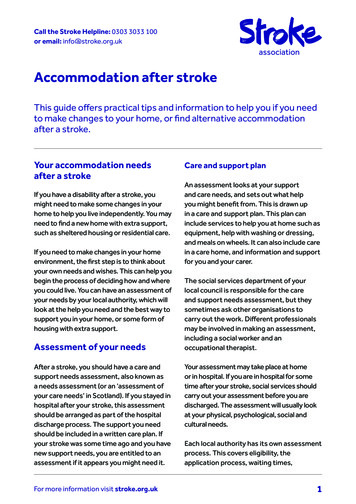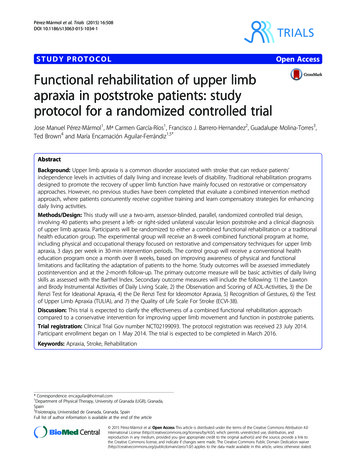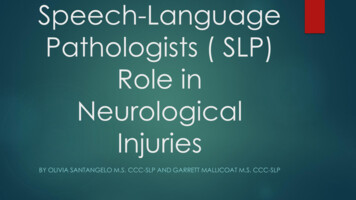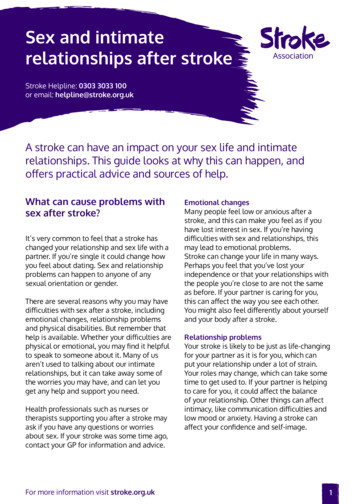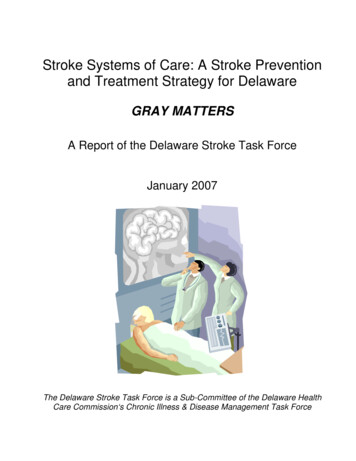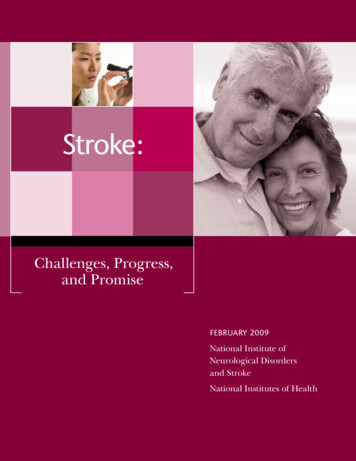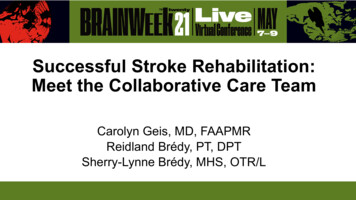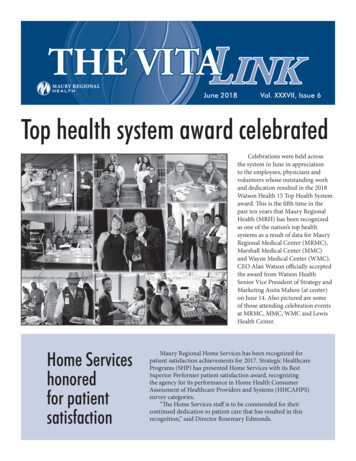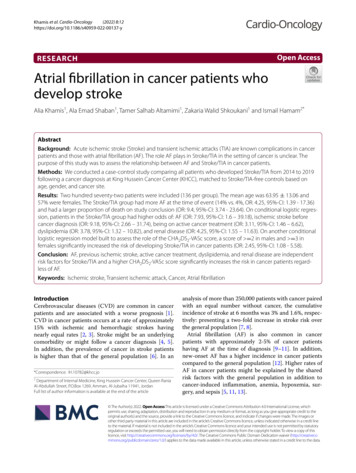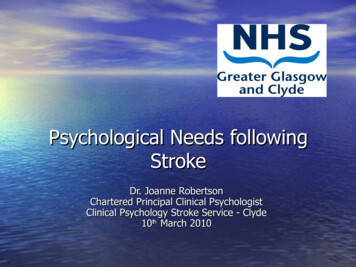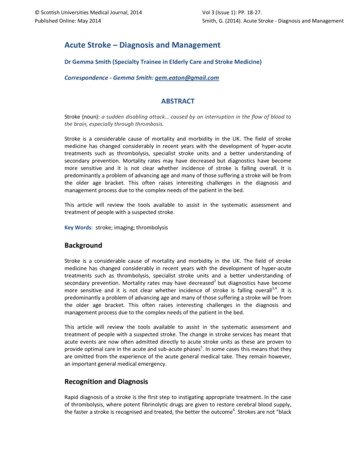
Transcription
Apraxia following stroke:Identification and interventionsUK Stroke Forum29th Nov 2016Thérèse Lebedis (Jackson)Consultant Occupational Therapist in StrokeNHS Grampian1
ROY AND SQUARE PROCESSING MODEL een visual,auditory and objectinformationCONCEPTUALSYSTEMKnowledge of:- Object function- Action- SequencingactionsPRODUCTIONSYSTEMInvolves:- Organise and controlresponse selection- Execution (correctforce, direction andtiming)Roy & Square 19962
APRAXIA A cognitive motor planning disorderleading to an inability to perform actionsin the absence of weakness or sensoryloss Prevalence – 1/3 of those in rehabilitationcentres and nursing homes following lefthemisphere strokeDonkervoort 20003
APRAXIA A disorder of learned, voluntary actionsresulting from neurological impairmentRothi LJG and Heilman KM (1997) Ideomotor ApraxiaIdeational Apraxia4
Ideomotor Apraxia A disorder in the initiation and executionof planned sequences of movement. Theconcept of the task is understood but themovements lack the correct force,direction and timing in order to achieve amotor goal.5
Ideational Apraxia A disorder in the performance of skilledactivity because the concept of the actionrelated to the object is impaired.A disturbance in the conceptualorganisation of actions6
Butler J. How comparable are tests of apraxia?Clinical Rehabilitation 2002; 16: 389-398 (2002) “until a gold standard test of apraxia is found, thatwe don’t rely on, just one test of apraxia for diagnosisand that we consider the functional and behaviouralindices in ADL tasks as more clinically relevant thanpure test scores”“ the need for expert judgement to interpret errorsremains apparent”7
Behavioural observations Tasks which can be used in a functionalsetting e.g. Making a cold drinkPutting paper in an envelopeHole punching paper and putting it in an A4file. Zwinkels et al (2004)8
Dovern J. ‘Diagnosis and treatment of upper limbapraxia’ Neurol (2012) 259 1269-1283 Screening tool AST – Apraxia Screen of TULIA (Vanbellingen et al) CAS – Cologne Apraxia Screen (Weiss et al)Clinical diagnosis Apraxia test by De Renzi et al Test of Upper Limb Apraxia (TULIA)Research/scientific purposes Apraxia test by Alexander et al Test Battery by Bartolo et al The Florida Apraxia Battery & Revised Sydney(FABERS)9
Measurement of disability inpeople with apraxia Observational method of assessmentusing four activities of daily livingActivity performance is scored on a fourpoint rating scaleThese descriptors assess the disabilitycaused by apraxia as they focus on thestage at which the performance of theactivity breaks down, rather than thecause.van Heugten et al (2000)10
Ideomotor ApraxiaPerformance errors Spatial orientation errorsTemporal imprecision errors (timingerrors)Errors of the force of movementPoor distal differentiationBody part as objectGestural enhancementVocalisation11
Ideational ApraxiaPerformance errors Inappropriate object useSequencing errors - omission / incompleteBlending sequences togetherAction overshoots what's requiredAction remains incompletePerseveration12
Cognitive RehabilitationApproachesRestitution – aimed at reducing specificcognitive deficitsSpecific skills training – aimed at improvingfunctional task ability*Substitution or cognitive strategy training –teach people new ways to deal with dailylife problems13
Activities in context Appropriate environment Goldenberg & Hagmaan 1998Structured tasks Goldenberg & Hagmaan 1998; Wilson 1998Goal directed activity Goldenberg and Hagman 1998Task specific training Park S et al 1994Errorless learning Clark et al 1994Wilson 1998Practice and repetition of meaningful tasks Goldenberg & Hagmaan 1998; Wilson 1998
West C et al. Interventions for motor apraxiafollowing stroke (review) The CochraneCollaboration 2008, Issue 1 Objective of review – to determine which interventionstargeted at motor apraxia reduce disability Included RCTs of therapeutic intervention for motorapraxia in stroke – 3 trials, 132 patients Results – evidence of a small but short lived therapeuticeffect in the two studies that reported change in ADLs –effect did not persist in the longer termConclusion – insufficient evidence to support or refute theeffectiveness of specific therapeutic interventions formotor apraxia after stroke.15
Strategy training - ApraxiaStage of activity Initiation Execution ControlIntervention Instruction Assistance FeedbackDonkervoort M et al. (2001) Efficacy of strategytraining in left hemisphere stroke patients withapraxia: a randomised clinical trial.Neuropsychological Rehabilitation, 11, 549-566
Transfer effectsFor patients to function as independently aspossible at home and in society, two types oftransfer of treatment effects are needed Tasks taught in the rehab setting should betransferred to the home setting Transfer of intervention effects from trained tonon trained (related) tasks is important interms of the clinical success of a therapyprogramme as not all difficulties can be dealtwith in therapy programmes Geusgens C et al 2006 & 2007
THANK YOUEmail: therese.lebedis@nhs.net18
References Butler J. How comparable are tests of apraxia? Clinical Rehabilitation 2002;16: 389-398 (2002)Clark et al (1994) Spatial deficits in limb apraxia. Brain 117, 1093 – 1106.De Renzi et al (1980) Imitating gestures: a quantitative approach toideomotor apraxia. Archives of Neurology, 37, 6-18.Donkervoort M, Dekker J, Stehmann-Saris J, Deelman BG. (2001) Efficacyof strategy training in left hemisphere stroke patients with apraxia; arandomised clinical trial. Neuropsychological Rehabilitation 11(5); 549-566Dovern J Diagnosis and treatment of upper limb apraxia’ Neurol (2012) 2591269-1283Geusgens C, Van Heugten C, Cooijmans J, Jolles J, and Van den Heuvel W.Transfer effects of a cognitive strategy training for stroke patients withapraxia: An exploratory study Neuropsychological Rehabilitation. 2006,16(2), 213-229Geusgens C, Van Heugten C, Donkervoort M, Van den Ende E, Jolles J, andVan den Heuvel W. Transfer of training effects in stroke patients withapraxia. Journal of Clinical and Experimental neuropsychology 2007, 29(8), 831-84119
Goldenberg G, & Hagmann S, (1998) Therapy of activities of daily living inpatients with apraxia. Neuropsychological Rehabilitation, 8, (2) 123-141.Rothi L.J.G and Heilman K.M. Eds. (1997). Apraxia. The Neurospychologyof Action. East Sussex: The Psychology Press.Roy EA (1996) hand preference, manual asymmetries & limb apraxia. InElliott EA Roy eds. Manulal asymmetries in motor control. Boca Raton, FLCRC PressVanbellingen T, Kersten B, Van de Winckel A, Bellion M, Baronti F, Muri R,Bohlhalter S (2011) A new bedside test of gestures in stroke: the apraxiascreen of TULIA (AST). J Neurol Neurosurg Psychiatry 82(4):389–392van Heugten CM, Dekker J, Deelman BG, van Dijk AJ, Stehmann Saris JCand Kinebanian A (1998) Outcome of strategy training in stroke patientswith apraxia, a phase II study : Clinical Rehabilitation: 12 :216 – 225van Heugten, Bekker J, Deelman BG, van Djil AJ, Stehmaan-Saris, FC &Kinebanian A. A Diagnostic Test for Apraxia in Stroke Patients: Internalconsistency and Diagnostic value. The Clinical Neuropsychologist 1999, 13,No 2 182 -192van Heugten, Dekker J, Deelman BG, van Djil AJ, Stehmaan-Saris, FC &Kinebanian A Assessment of disabilities in stroke patients with apraxia:Internal consistency and Inter-observer reliability. The OccupationalTherapy Journal of research. 1999. Vol 19, No1.20
. Smania N, Girardi F, Domenicali C, Lora E, Aglitori S. (2000) Therehabilitation of limb apraxia: a study in left brain damaged patients.Archives of Physical Medicine and Rehabilitation 81: 379-88. Smania N, Aglioti SM, Girardi F, Tinazzi M, Fiaschi A, Cosentino A, Corato E(2006) Rehabilitation of limb apraxia improves daily life activities inpatients with stroke. Neurology 67:2050–2052 West C et al. Interventions for motor apraxia following stroke (review)The Cochrane Collaboration 2008, Issue 1 Wilson B (1988) Remediation of apraxia following an anaesthetic accident.In: J West, P Spinks, eds. Case studies in clinical psychology. Bristol: JohnWright Zwinkels A, Geusgens C, van de Sande P, van Heugten C. Assessment ofApraxia: inter rater reliability of a new apraxia test, association betweenapraxia and other cognitive deficits and prevalence of apraxia in arehabilitation setting. Clinical Rehabilitation. 2004;18: 819 – 82721
screen of TULIA (AST). J Neurol Neurosurg Psychiatry 82(4):389-392 van Heugten CM, Dekker J, Deelman BG, van Dijk AJ, Stehmann Saris JC and Kinebanian A (1998) Outcome of strategy training in stroke patients with apraxia, a phase II study : Clinical Rehabilitation: 12 :216 -225
